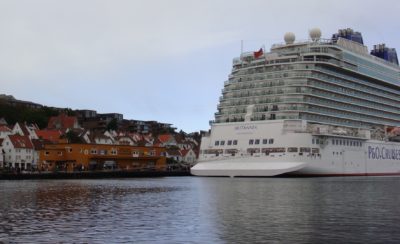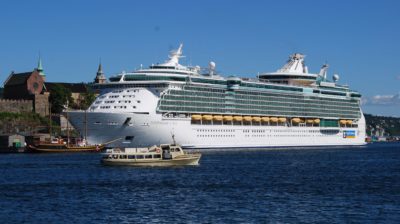A few cruiseships are venturing back into Norwegian harbours, to a mixed welcome. While some local officials are glad to see them return, others warn that the Corona crisis is far from over and many passengers won’t be allowed to go ashore.

“We’re very glad the ships are now coming,” Solrunn Hjelleflat, chief executive of Aurland Ressurs-utvikling, told state broadcaser NRK this week. Aurland has long been a major cruise destination, and Hjelleflat’s business runs three hotels and the popular Flåmsbane, which offers scenic train rides up the mountain from the fjord.
“We didn’t think we’d be getting any cruiseships for the rest of the year,” Hjelleflat told NRK. On August 9, however, she’s expecting the first cruiseship since the end of February to sail up the Nærøyfjord. The Norwegian government has opened Norway’s ports to cruiseships again, as long as they follow strict infection control procedures. The vessels, for example, can only use half of their passenger capacity, and various Corona containment rules apply to both passengers and crew.
Passengers on board the vessel due to arrive in Aurland will also have to admire the scenery from the deck or through the ship’s windows, since the cruise line itself reportedly won’t allow them to disembark. “We would of course preferred to have the visitors come ashore,” Hjelleflat said, but it’s a cautious start to what she hopes will be a comeback for the cruise industry.
‘Positive signal’
“Cruise tourism accounts for 20 percent of our revenues,” said Øyvind Holsen, sales and marketing director for Flåm AS, a subsidiary of Aurland Ressursutvikling. “We reckon we’re losing nearly 70 percent of our total revenues for 2020 as a result of (Corona-related) travel restrictions.” He told NRK that just the sight of a cruiseship raises hopes for local businesses:
“It’s one of many positive signals that have begun to come recently.”
The mountain communities of Geiranger and Loen are also looking forward to seeing cruiseships again from September, as is Eidfjord in Hardanger. As one cruiseship turned up in Oslo on Wednesday, however, cruise critics won’t be looking forward to the emissions they can generate, or the hordes of tourists that ultimately can pour off the large ships.

“Stavanger can end up as Norway’s Venice,” grumbled local politician Mímir Kristjánsson before the Corona crisis began. He told newspaper Dagbladet that he feared Stavanger residents would end up moving out of town and renting out their homes through Airbnb. Stavanger had 234 cruiseship arrivals last year with fully 454,000 passengers on board, nearly four times the population of Stavanger itself. Bergen was overrun with around 600,000 cruise tourists, prompting lots of complaints from the locals.
Oslo took in 123 ships and with 233,000 cruise passengers on board. That was due to rise to 145 ships carrying 269,000 passengers this year, until Corona forced the ships into layup all over the world. Harbour authorities like the docking fees paid by the ships, but they’re often on a collision course with local politicians that hear the locals’ complaints. Oslo’s city government, controlled by the Labour, Socialist Left and Greens parties, has promised to limit cruiseship arrivals even as harbour authorities plan increases.
‘Halting cruise activity’
“I have asked Oslo Havn (the harbour authority) to reduce and eventually halt cruise activity at Vippetangen and Søndre Akershus,” Labour’s city politician in charge of business and trade, Victoria Marie Evensen, told newspaper Klassekampen in February. Both pier areas attract large cruiseships that can block the view to Oslo’s historic Akershus Fortress for as long as they’re in port, but the biggest reasons for the crackdown are their emissions and large crowds of tourists off the ships who don’t contribute to the local economy nearly as much as other tourists. Most don’t stay in Oslo hotels, they don’t spend their shore time in often pricey restaurants or cafés and they often only buy a few souvenirs.
Aftenposten reported late last year on a survey by business development agency Innovation Norway that showed how cruise tourists’ direct contribution had sunk from NOK 2.3 billion in 2014 to NOK 1.8 billion in 2019, despite the increase in ships and passengers. The same survey showed that 92 percent of the money paid by passengers went to the cruiselines and their owners.

Cruise line promoters argue that they do make an economic contribution, but perhaps moreso in outlying districts than in Norway’s cities. “For many tourist destinations in districts without an airport and poor roads, cruise is a pillar of the cruise industry,” wrote Inge Tangerås, leader of the industry trade association Cruise Norway AS in newspaper Aftenposten earlier this month. “Cruise uses the seas, has a longer season than other tourism sectors and provides volume and predictable revenues for businesses at the ports of call.”
That’s why places like Flåm and Geiranger welcome the ships, while residents of Bergen, Stavanger and Oslo don’t. Major Norwegian investors in the cruise industry like the family of the late shipowner Arne Wilhelmsen, who helped found and still owns 12 percent of Royal Caribbean Cruisees, and Torstein Hagen of Viking Cruises have clearly lost billions on the Corona shutdown.
“Hardly any branch has been as hard-hit as the cruise business,” wrote Kjetil Wiedswang, commentator in newspaper Dagens Næringsliv (DN), last spring. The first major warning of the crisis came as the Diamond Princess remained caught in quarantine in Japan with 3,711 passengers on board and hundreds infected with the virus. Harbours all over the world turned away cruiseships viewed as what Wiedswang called “floating infection bombs.”
Safety and health ‘our highest priority’
Questions remain over whether cruise passengers will return in the same numbers as before. Cruiseships have had problems with infectious viruses before, but nothing like Corona. The cruiselines themselves are likely to do all they can to attract customers again.
“The safety and health of passengers, crews and the local communities (visited) are our highest priority,” Tor Christian Sletner, vice president of Cruise Lines International Association (CLIA), wrote in Aftenposten recently. “When the pandemic was a fact, the cruise industry was among the first to suspend operations globally. We are highly regulated by international organizations, flag states and harbours.” He noted that CLIA members also must follow strict internal guidelines that he claimed are often stricter than international and national laws demand.”
“We promise that the cruiseships will be coming back when Norwegian society is ready for them again,” Sletner wrote. “We’re sorry for the losses that the suspension of operations caused for districts and businesses along the coast, but we’re coming back.”
NewsInEnglish.no/Nina Berglund

